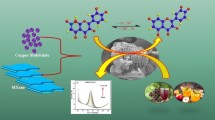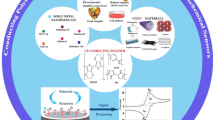Abstract
Multiwalled carbon nanotubes (CNT) doped polyaniline (Pani) nanocomposite has been electrochemically deposited onto indium tin oxide (ITO)-coated glass substrate for fabrication of uric acid biosensor. To achieve this, uricase (from Bacillus fastidiosus) has been covalently immobilized onto glutaraldehyde-modified CNT-Pani/ITO and characterized using cyclic voltammetry (CV), scanning electron microscopy (SEM), Fourier transform infrared (FTIR) spectroscopy, electrochemical impedance spectroscopy (EIS), etc. CV studies of CNT-Pani/ITO electrode reveals that the system obeys quasi-reversible electron transfer behavior with diffusion coefficient of 2.3346 × 10−8 cm s−1 in K3FeCN6. Fabricated uricase-CNT-Pani/ITO electrodes were tested for uric acid detection in buffer and spiked serum samples electrochemically. It was found that fabricated electrode was able to detect 0.01–1.0 mM uric acid using CV and 0.02–0.8 mM uric acid using differential pulse voltammetry (DPV). The enhanced electrochemical performance of this biosensor is due to the high enzyme loading synergistically connected to CNT-Pani nanocomposite leading to improved enzyme characteristics such as Km value of 4.85 × 10−3 mM L−1 (about 70 times less than the free enzyme), sensitivity of 43.2 μA mM−1 for CV-based detection and 8.38 μA mM−1 for DPV-based detection within response time of 60 s. Fabricated electrodes were able to maintain their electrochemical activity with 60 times reusability and were stable up to 28 weeks when stored at 4 °C.





Similar content being viewed by others

References
Poudel, B., Yadav, B. K., Kumar, A., Jha, B., & Raut, K. B. (2014). Journal of Tropical Biomedicine, 4, 59–64.
Arora, K., Sumana, G., Saxena, V., Gupta, R. K., Gupta, S. K., Yakhmi, J. V., et al. (2007). Analytica Chimica Acta, 594, 17–23.
Ali, S. M. U., Alvi, N. H., Ibupoto, Z., Nur, O., Willander, M., & Danielsson, B. (2011). Sensors and Actuators B, 152, 241–247.
Wanekaya, A. K., Chen, W., Myung, N. V., & Mulchandani, A. (2006). Electroanalysis, 18, 533–550.
Arora, K., Chand, S., & Malhotra, B. D. (2006). Analytica Chimica Acta, 568, 259–274.
Yang, D. S., Jung, D. J., & Choi, S. H. (2010). Radiation Physics and Chemistry, 79, 434–440.
Iiloma, S. (1991). Nature, 354, 56–58.
Heer, W. A., Charelain, A., & Ugarte, D. (1995). Science, 270, 1179–1180.
Jiang, Y., Wang, A., & Kan, J. (2007). Sensors and Actuators B, 124, 529–534.
Kan, J., Pan, X., & Chen, C. (2004). Biosensors and Bioelectronics, 19, 1635.
Castillo-Ortega, M. M., Rodríguez, D. E., Encinas, J. C., Plascencia, M., Mendez-Velarde, F. A., & Olayo, R. C. (2002). Sensors and Actuators B, 85, 19.
Behera, S., & Raj, C. R. (2007). Sensors and Actuators B, 128, 31–38.
Zhang, F. F., Xiao-Li Wang, X. L., Li, C. X., Li, X. H., Wan, Q., Xian, Y. Z., et al. (2005). Analytical and Bioanalytical Chemistry, 382, 1368–1373.
Chen, D., Wang, Q., Jin, J., Wu, P., Wang, H., Yu, S., et al. (2010). Analytical Chemistry, 82, 2448–2455.
Liu, A., Honma, I., & Zhou, H. (2007). Biosensors and Bioelectronics, 23, 74–80.
Chauhan, N., & Pundir, C. S. (2011). Analytical Biochemistry, 413, 97–103.
Yiting, W., Lei, Y., Ziqiang, Z., Jian, Z., & Jianzhong, Z. (2009). Analytical Letters, 42, 775–789.
Zhao, Y., Yan, X., Kang, Z., Lin, P., Fang, X., Lei, Y., et al. (2013). Microchimica Acta, 180, 759–766.
Jeykumari, D. R. S., Kumar, S. S., & Narayanan, S. S. (2005). Pramana Journal of Physics, 65, 731–738.
Datsyuk, V., Kalyva, M., Papagelis, K., Parthenios, J., Tasis, D., Siokou, A., et al. (2008). Carbon, 46, 833–840.
Pruneanu, S., Veress, E., Marian, I., & Oniciu, L. (1999). Journal of Material Science, 34, 2733–2739.
Randles, J. E. B. (1948). Transactions of Faraday Society, 44, 322–327.
Bard, A. J., & Faulkner, L. R. (2000). Electrochemical Methods: fundamentals and applications (2nd ed.). New York: Wiley.
Pengm, H., Mo, Z., Liao, S., Liang, H., Yang, L., Luo, F., et al. (2013). Science Reports, 3, 1765.
Silverstein, R. M., & Webster, F. X. (2002). Spectrometric identification of organic compounds sixth edition. India: Wiley. 165.
Saraf, R. (2013). International Journal of Nano Devices, 2, 1–6.
Gerard, M., Ramanathan, K., Chaubey, A., & Malhotra, B. D. (1999). Electroanalysis, 11, 450.
Stilwell, D. E., & Park, S. M. (1988). Journal of the Electrochemical Society, 135, 2491.
Piermarini, S., Migliorelli, D., Volpe, G., Massoud, R., Pierantozzi, A., Cortese, C., et al. (2013). Sensors and Actuators B, 179, 170–174.
Liu, Y., Yuan, M., Liu, L., & Guo, R. (2013). Sensors and Actuators B, 176, 592–597.
Rawal, R., Chawla, S., Chauhan, N., Dahiya, T., & Pundir, C. S. (2012). International Journal of Biological Macromolecules, 50, 112–118.
Lei, Y., Liu, X., Yan, X., Song, Y., Kang, Z., Luo, N., et al. (2012). Journal of Nanoscience and Nanotechnology, 12, 513–518.
Chu, H., Wei, X., Wu, M., Yan, J., & Tu, Y. (2012). Sensors and Actuators B, 163, 247–252.
Acknowledgments
We are grateful to Prof. Sopory, Vice Chancellor, JNU, and Prof. Bhudhani, Director, NPL, New Delhi, India for their constant encouragement and infrastructural support. DST-PURSE, DBT sponsored projects IYBA-2008 (BT/B1/12/045/2008) andRGYI-2009 (BT/PR13127/GBD/27/195/2009) are duly acknowledged.
Author information
Authors and Affiliations
Corresponding author
Rights and permissions
About this article
Cite this article
Arora, K., Choudhary, M. & Malhotra, B.D. Enhancing Performance of Uricase Using Multiwalled Carbon Nanotube Doped Polyaniline. Appl Biochem Biotechnol 174, 1174–1187 (2014). https://doi.org/10.1007/s12010-014-0996-x
Received:
Accepted:
Published:
Issue Date:
DOI: https://doi.org/10.1007/s12010-014-0996-x



